This study investigates the anatomy of a cadaveric hand presenting with a rare malformation that we identified as a form of brachydactyly. We performed a layer-by-layer dissection of the affected cadaveric hand and documented both the normal and variant anatomical compositions that were present. The osteology revealed complete aplasia of the proximal and middle phalanges of the second, third, fourth, and fifth digits along with truncated distal phalanges of the fourth and fifth digits. The radius, ulna, carpal bones, and the first digit were unremarkable. Neurovasculature followed standard anatomical courses. Normal development of surrounding musculature was observed.
Congenital hand malformations are infrequently observed in the anatomy lab and provide a unique learning opportunity for students and faculty alike. While hand deformities are frequently imaged through noninvasive techniques such as X-rays and CT imaging, they are infrequently dissected. Through dissection, clinicians and anatomists may be able to adopt a more tangible appreciation for the underlying anatomy of this condition.



